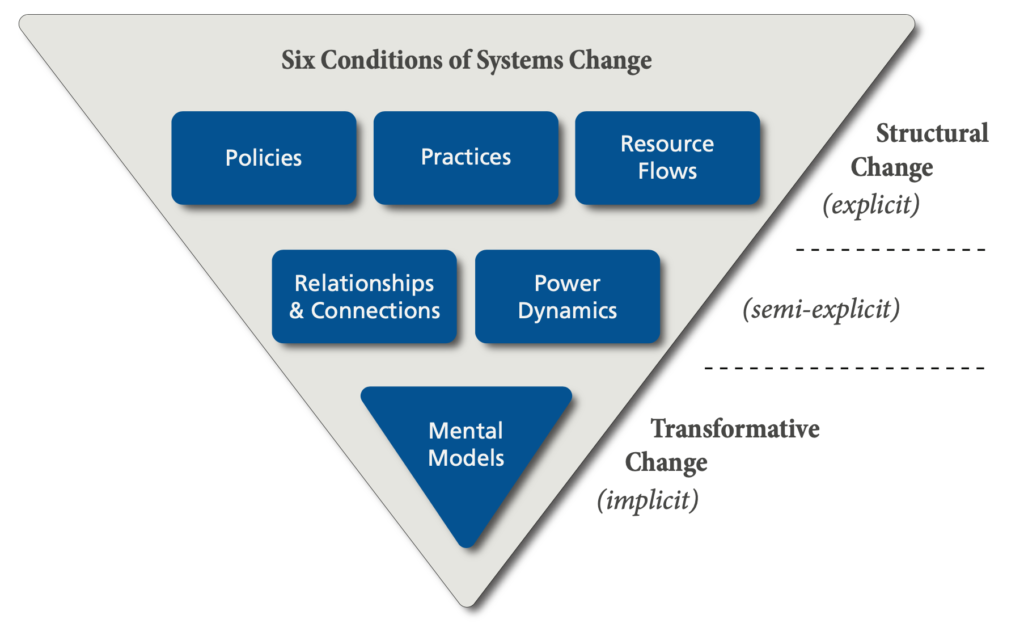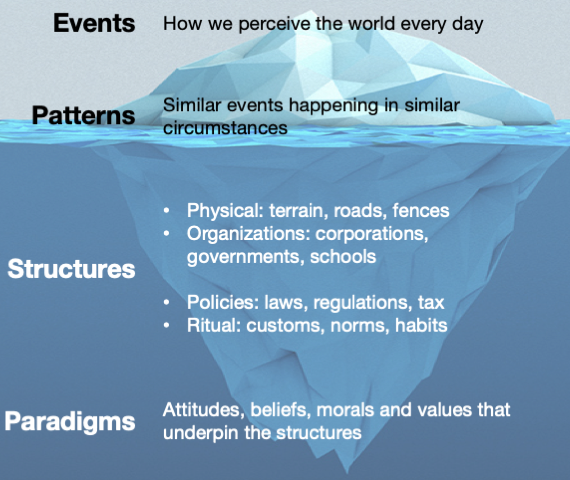Currently there seems to be a lot going on around systems change, particularly driven by a few organisations that have picked up the topic and drive it forward, including large philanthropic funders that so far have mainly focused on social entrepreneurship and social innovation. They seem to have raised that with simply scaling social enterprises or social innovations, systemic change does not happen and that a systemic view on change is needed. So they have started to put together research projects on figuring out what systemic change is. One thing that emerges from these initiatives is hopefully a wider agreement on what is meant by systems change, which all systems change practitioners could profit from. I’m happy to see that the way I have been thinking about systems change seems to be largely aligned with that emerging consensus.
The definition of what systemic change or systems change (I don’t think there is a difference between the two) is converges around changes in structures that shape the current situation. A very simple but useful definition of systems change comes from the Social Innovation Generation (SIG) in Canada: shifting the conditions that are holding the problem in place (quoted in Kania, Kramer and Senge 2018. This is in line with what I called transformative change – a transformation of the system’s structure. We do not just have to solve the problem but we want to transform the conditions that are holding the problem in place.
Conditions for systems change
In this definition there is an understanding that what we observe in our daily lives is the outcome of a very intricate structure of arrangements that has evolved over long periods of time, partly since the dawn of mankind. This outcome can be identified as favourable or not. If people are poor and businesses struggle to become competitive and grow, the outcomes are not favourable. If everybody is happy and can flourish, the outcomes are favourable. The structures that are shaping the outcomes include regulations, economic configurations and cultural assumptions. John Kania, Mark Kramer and Peter Senge have in their 2018 report “The Water of Systems Change” distilled six types of conditions that shape the current expression of a system, as illustrated in the following figure.

Obviously we can have discussions about the terms and concepts they use. For example I am not sure I would only call a change transformative if it reaches the level of mental models (in this regard I also like the term ‘paradigm’ used by Donella Meadows more than ‘mental models’). But I still think that the idea of understanding the conditions that hold specific systemic outcomes in place a useful one. And it is not a new one, the Systems Iceberg (figure below), which I use a lot, has been around for a while. It is going back to Meadow’s work on leverage points to intervene in a system (although Meadow’s thinking has also evolved from when she formulated the leverage points away from a more mechanistic understanding of system dynamics and towards an understanding that is more in line with complexity thinking, in which she talks about dancing with systems).

Mapping constraints
Dave Snowden makes a similar point. He talks about constraints and advocates that in order to understand behaviour we need to map the constraints that are in place. Constraints, he argues, are one of the few elements in complex systems that we can manage. He developed a typology of constraints that includes two groups of constraints: robust constraints like robust walls or elastic boundaries and resilient constraints like permeable boundaries or boundaries that are context sensitive.
This typology allows us to recognise different types of constraints and in particular it allows us to understand which types of constraints work in which circumstances – for example robust constraints seldom work in complex situations where resilient constraints are much better suited.
Snowden’s typology is more abstract than the six conditions of systems change by Kania, Kramer and Senge – which is not necessarily a bad thing as it makes it more universally applicable.
Conditions for change and Covid-19
What is the link from this discussion to the current situation with the Covid-19 pandemic? Its quite simple. What we observe now is quite an unprecedented situation and has fundamentally changed the life of all of us. Individuals, organisations, enterprises and governments needed to change how things are done – and ideally fast. In many countries, people need to stay and work at home, and schools, restaurants, bars and most shops are closed. Many organisations had to drastically reorganise the way they do things. This ‘new way of doing things’ is in many cases so radical that it would have violated many conditions that held the previous situation in place. Hence, the leaders in the organisations and also in the government had to override many of these conditions. So now things are possible that weren’t possible before.
Suddenly, things can be done via online meetings that before were only possible in person. Suddenly, money is available can be spent on things that before would have amounted to a fundamental break with ideology. Suddenly, things can be done in fractions of the time spans they used to take before.
Of course this is a crisis and what needs to be done needs to be done. And fast. But what will be important is to ask which of these changes are actually better than what we had before, also for normal situations. Which of the underlying conditions that held the situation in place and that were now overridden should we keep suspended or replaced with a new one? It is often difficult to answer these questions in the moment and after a crisis there is often the tendency to go back to how things were before. This is why it is extremely important to put in place learning processes during crises to capture the new ways of doing things in a way so they can be reviewed in peace once the crisis is over. Dave Snowden recommends:
In a crisis, you should always deploy an innovation team alongside the business recovery teams…to capture the novel practice
Some people have been doing this in the case of the Covid-19 crisis, as is describe in this blog post by What’s The Pont. I have also offered via Twitter that I would volunteer to support organisations to maximise the learning they can get out of the current crisis situation and I have had some interest. If you are interested, get in touch!
So, to conclude, I think the discussion about systemic change is going into a positive direction, even though there are still quite a few practitioners out there that are taking a rather reductionist perspective on the concept. The contrast between the two perspectives has been nicely described by my former colleague at the BEAM Exchange Mike Albu in his recent blog post on measuring job creation.
Feature Image by Markus Spiske on Unsplash


Hi Marcus. What are the research projects you mention in the first paragraph? Would be great if you could share. Thanks!
Hi Jake.
The most prominent I have come across now is the SKOLL and Saïd Business School’s Systems Change Observatory: https://www.sbs.ox.ac.uk/research/centres-and-initiatives/skoll-centre-social-entrepreneurship/systems-change-observatory
More of a field-building initiative with no real online presence yet is Illuminate: https://mailchi.mp/cf0bdef6497a/illuminate
Then there are multiple organisations like Forum for the Future: https://www.forumforthefuture.org/ or the Academy for Systems Change that have been writing and publishing for longer: https://www.academyforchange.org
Great, thanks very much!